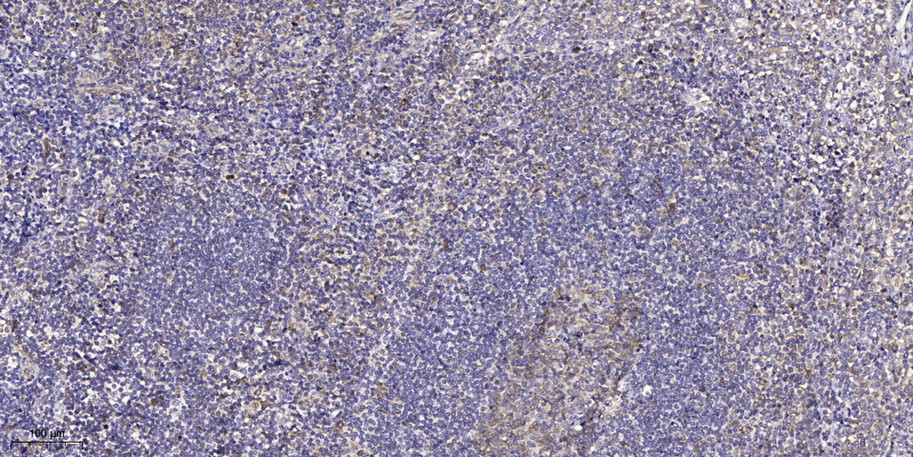C/EBP δ/ε Polyclonal Antibody
- Catalog No.:YT0556
- Applications:WB;IHC;IF;ELISA
- Reactivity:Human;Mouse;Rat
- Target:
- C/EBP δ/ε
- Gene Name:
- CEBPD/CEBPE
- Protein Name:
- CCAAT/enhancer-binding protein delta/epsilon
- Human Gene Id:
- 1052/1053
- Human Swiss Prot No:
- P49716/Q15744
- Mouse Gene Id:
- 12609/110794
- Rat Gene Id:
- 25695/25410
- Rat Swiss Prot No:
- Q03484/P56261
- Immunogen:
- The antiserum was produced against synthesized peptide derived from human CEBPD/E. AA range:171-220
- Specificity:
- C/EBP δ/ε Polyclonal Antibody detects endogenous levels of C/EBP δ/ε protein.
- Formulation:
- Liquid in PBS containing 50% glycerol, 0.5% BSA and 0.02% sodium azide.
- Source:
- Polyclonal, Rabbit,IgG
- Dilution:
- WB 1:500 - 1:2000. IHC 1:100 - 1:300. IF 1:200 - 1:1000. ELISA: 1:20000. Not yet tested in other applications.
- Purification:
- The antibody was affinity-purified from rabbit antiserum by affinity-chromatography using epitope-specific immunogen.
- Concentration:
- 1 mg/ml
- Storage Stability:
- -15°C to -25°C/1 year(Do not lower than -25°C)
- Other Name:
- CEBPD;CCAAT/enhancer-binding protein delta;C/EBP delta;Nuclear factor NF-IL6-beta;NF-IL6-beta;CEBPE;CCAAT/enhancer-binding protein epsilon;C/EBP epsilon
- Observed Band(KD):
- 28kD
- Background:
- The protein encoded by this intronless gene is a bZIP transcription factor which can bind as a homodimer to certain DNA regulatory regions. It can also form heterodimers with the related protein CEBP-alpha. The encoded protein is important in the regulation of genes involved in immune and inflammatory responses, and may be involved in the regulation of genes associated with activation and/or differentiation of macrophages. The cytogenetic location of this locus has been reported as both 8p11 and 8q11. [provided by RefSeq, Sep 2010],
- Function:
- function:C/EBP is a DNA-binding protein that recognizes two different motifs: the CCAAT homology common to many promoters and the enhanced core homology common to many enhancers. Important transcriptional activator in the regulation of genes involved in immune and inflammatory responses, may play an important role in the regulation of the several genes associated with activation and/or differentiation of macrophages.,similarity:Belongs to the bZIP family. C/EBP subfamily.,similarity:Contains 1 bZIP domain.,subunit:Binds DNA as a dimer and can form stable heterodimers with C/EBP alpha. Interacts with SPI1/PU.1.,
- Subcellular Location:
- Nucleus .
- Expression:
- Cerebellum,Placenta,
- June 19-2018
- WESTERN IMMUNOBLOTTING PROTOCOL
- June 19-2018
- IMMUNOHISTOCHEMISTRY-PARAFFIN PROTOCOL
- June 19-2018
- IMMUNOFLUORESCENCE PROTOCOL
- September 08-2020
- FLOW-CYTOMEYRT-PROTOCOL
- May 20-2022
- Cell-Based ELISA│解您多样本WB检测之困扰
- July 13-2018
- CELL-BASED-ELISA-PROTOCOL-FOR-ACETYL-PROTEIN
- July 13-2018
- CELL-BASED-ELISA-PROTOCOL-FOR-PHOSPHO-PROTEIN
- July 13-2018
- Antibody-FAQs
- Products Images
.jpg)
- Western Blot analysis of LOVO cells using C/EBP δ/ε Polyclonal Antibody diluted at 1:500 cells nucleus extracted by Minute TM Cytoplasmic and Nuclear Fractionation kit (SC-003,Inventbiotech,MN,USA).

- Western Blot analysis of RAT-MUSCLE cells using C/EBP δ/ε Polyclonal Antibody diluted at 1:500 cells nucleus extracted by Minute TM Cytoplasmic and Nuclear Fractionation kit (SC-003,Inventbiotech,MN,USA).

- Western blot analysis of lysates from LOVO and RAW264.7 cells, using CEBPD/E Antibody. The lane on the right is blocked with the synthesized peptide.

- Immunohistochemical analysis of paraffin-embedded human tonsil. 1, Antibody was diluted at 1:200(4° overnight). 2, Tris-EDTA,pH9.0 was used for antigen retrieval. 3,Secondary antibody was diluted at 1:200(room temperature, 45min).



